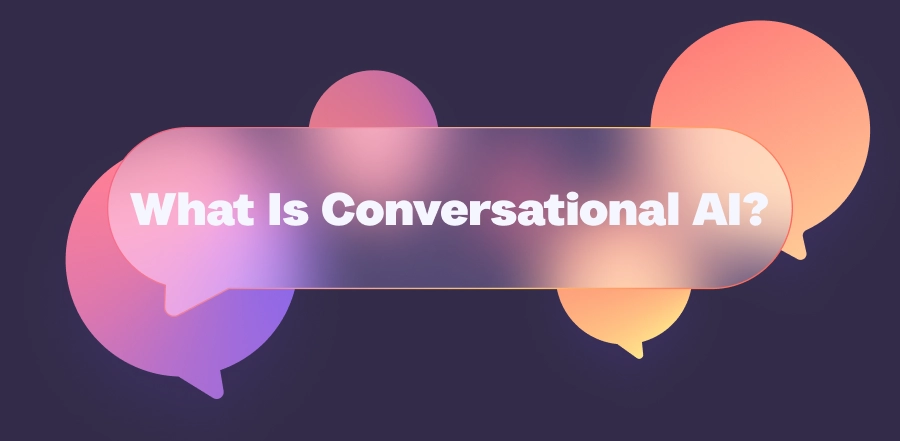What Is Conversational AI and How Does It Work?
• Customer Support
• FastBank

Whether we notice it or not, we interact with computers quite frequently. And when a machine manages to come up with a witty, smart, human-like reply, our interactions become much more enjoyable. This is achieved through conversational AI.
From automated emails and voice assistants, conversational AI is what runs behind the scenes to enable the dialogue to flow. It analyzes the text or speech, identifies the intent, and provides a suitable response to match that intent.
Read on to learn what conversational AI is, how it works, what it offers, and how you can implement it!
What Is Conversational AI?
Let’s start by defining the term:
Conversational AI is a technology that enables machines to communicate with people in a human-like manner. This can happen through spoken or written text, depending on the type of conversational AI software.
In any conversation AI has with a person, there are several technologies in use. Conversational AI uses machine learning, deep learning, and natural language understanding (NLU) to digest large amounts of data and learn how to best respond to a given query. A huge benefit is that it can work in any language based on the data it was trained on.
Conversational AI vs. Chatbots
Conversational AI and chatbots are often mixed up and used interchangeably, even though they’re not the same. Conversational AI is a broad concept implemented in various technologies and tools. It’s a collective term for different methods that enable machine-to-human conversations. The voice assistant you use to check the weather is one conversational AI example.
Conversely, a chatbot is a tool that may or may not implement conversational AI. The most common traditional chatbots don’t integrate much AI and typically run on fixed rules. That’s why chatbots sometimes fail to understand your question and give an irrelevant answer.
More advanced tools such as virtual assistants are another conversational AI example. They rely on AI more heavily and use complex machine learning algorithms to learn from data on their own and improve the conversation flow each time.
Conversational AI tools have contextual awareness that enables them to identify the intent and overlook misspelled words or differently formatted questions. In contrast, script-based chatbots can’t correctly decipher text they haven’t been trained for.
Benefits of Conversational AI
Conversational AI has a wide scope of use cases: It’s on websites, social media platforms, voice-activated assistants, smart home devices, and the like. As convenient as it is for personal use, it also offers many business advantages. Let’s unveil how conversational AI can benefit you and your business.
Cost Efficiency
Customers nowadays seek 24/7 support from companies, but maintaining a whole customer service department that operates around the clock is quite costly, especially for smaller businesses. While conversational AI can’t entirely substitute human agents, it can take care of most of the basic interactions, helping companies reduce the cost of hiring and training a large workforce.
Time Efficiency
Another business aspect where AI has proven its efficiency is time management. Conversations with clients can be very time-consuming, and most user queries tend to be repetitive or similar in nature. Businesses turn to AI customer service to save support agents the manual work of constantly responding to repeating requests. This creates a win-win scenario where customers get quick answers to their questions, and support specialists have more free time to attend to other issues. Read more about how to use the power of ChatGPT for customer service.
Increased Engagement and Sales
When users stumble upon a minor problem or confusion on a website, they don’t always call or email a support specialist. Instead, they abandon the site and try to find what they are looking for on another platform. This is a major loss for any business, and conversational AI software can help prevent this situation.
A friendly assistant that’s always ready to help users solve issues regardless of the time or day will prompt potential customers to stay on your website rather than turn to a competitor. In addition to that, it can also recommend products or services users might be interested in, thus increasing the likelihood of a purchase.
How Does Conversational AI Work?
To make sense of how conversational AI works, it’s crucial to understand its components. This type of AI combines machine learning and natural language processing (NLP). NLP analyzes human language, allowing machines to understand and converse with people. In the case of voice interactions, automatic speech recognition (ASR) is used to translate the spoken language into a written format.
Once the speech is translated into text through ASR and the text is analyzed through NLP, machines form a suitable response based on the intent they detected. The role of machine learning in this entire process is to study the available data to find patterns, make corrections, and improve the output over time.
Challenges of Conversational AI
As an evolving technology, conversational AI is still far from flawless and is being tested, modified, and improved every day. Using techniques such as reinforcement learning, it’s constantly digesting new information and refining its output. However, there are still a few obstacles this technology is currently wrestling with.
-
Linguistic Nuances
Human communication is not always straightforward; in fact, it often contains sarcasm, humor, variations of tones, and emotions that computers might find hard to comprehend. And when it comes to speech, dialects, slang, and accents are an extra challenge for AI to overcome.
-
Privacy Concerns
Conversational AI relies on information to operate, raising privacy and security concerns among some users. This leaves AI companies with the big responsibility of adhering to privacy standards and being transparent with their policies.
-
Public Skepticism
Any new advancement inevitably comes with some kind of apprehension from the general public. While it’s important to eliminate the misconceptions about chatbots and other AI products, researchers and tech companies need to realize that the public will need some time to warm up to and adopt novel technologies.
How to Implement Conversational AI Software
Now that you have a well-rounded understanding of conversational AI (with both its benefits and challenges), you might be wondering how to incorporate it into your business. Your options are the following: build a custom tool from scratch or use an existing conversational AI platform to speed up the process, such as a no code chatbot builder that allows you to create AI-powered chatbots without the need for programming knowledge.
Let’s break down the process of integrating an AI assistant into your business.
1. Specify Your Objectives
Regardless of which aspect of your business you’re striving to optimize, you need to define your pain points and objectives clearly. It could be updating your website or improving your website’s user experience, reducing response wait times, increasing sign-ups, or providing 24/7 availability to customers. Getting specific with the goals you want to achieve will help you pick the right tool.
2. Customize Your AI Assistant
Every company has its distinct personality, and to preserve and present yours, you need to customize your AI assistant to match your brand. It’s best to go with a customizable widget that you can entirely adjust to your distinct style. It might seem like a small detail, but every piece matters when you’re trying to build a coherent online image for your company.
3. Train Your Assistant
Just like you would teach a new employee to communicate with clients in a certain way and tone, you need to do the same for your assistant. After all, it’s just as integral to your company as your customer support team.
You can train your AI tool based on frequently asked questions, past tickets, and any other historical data you have. Be sure that the tone of voice your AI assistant uses is consistent with your brand identity.
4. Track and Optimize
With any new tool or practice that you introduce into your business, you need specific KPIs to assess its effectiveness. In the case of conversational AI, your KPIs might be first response time, average resolution time, chat to conversion rate, customer satisfaction score, and other similar metrics. Once you gain more experience and data, you can always return to retrain your assistant.
Last Words
Artificial intelligence keeps evolving, and so does its role in modern life. Conversational AI is the technology running behind conversations between humans and machines. It relies on NLP, ASR, and machine learning to make sense of and respond to human language.
Conversational AI tools have integrated into daily life and business, leaving their impact on both. The voice assistant on your device is an example of a conversational AI platform used for personal purposes. At the same time, there are chatbots and company VAs that serve to smooth out the customer journey and facilitate business processes.
Frequently Asked Questions
-
Is conversational AI part of NLP?
You can think of natural language processing as a set of techniques that help to create conversational AI. NLP is what gives machines the ability to break down, analyze, and understand human language and is, therefore, an essential part of conversational AI.
-
What is an example of conversational AI?
Personal assistants such as Siri, Alexa, and Google Assistant use conversational AI to interact with us. AI chatbots and virtual assistants are also conversational AI software popular among companies.
-
What problems does conversational AI solve?
Essentially, conversational AI’s mission is to automate repetitive tasks while increasing operational efficiency. Businesses use it to speed up customer support processes, ensure 24/7 availability, increase user engagement, and boost sales.

























